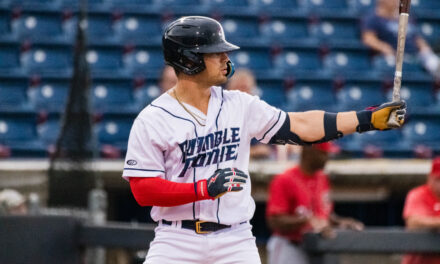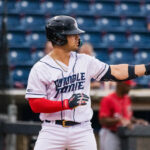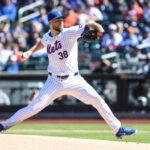While I´m quite tired of the “Omar vs. Sandy” debate, a recent post about the “strong farm system” Omar Minaya supposedly left behind in late 2010, got me thinking and looking.
To summarize, as of today, it doesn´t look as if the farm system left behind was all that good. And one big reason for the Mets´ recent and even current struggles is directly related to the lack of quality (not quantity of ) higher end homegrown talent that Minaya left behind for his successor. Don´t get me wrong, the system wasn´t barren either as some members of the media suggested back then. But if you take a closer look, it was mediocre at best – especially if you´re looking for potential short- and midterm help for the major league roster. And the effects are lasting.
Now, a few acknowledgements before I get into details:
- I very much respect Omar Minaya, one of the nicest persons you´ll find in all of Baseball.
- He did a good job, building what he was asked to do initially, i.e. a “quick fix winner” shortly after he took over. He had a “ Midas” touch for pretty much everything he did in the 2005/2006 off-season.
- Minaya inherited a great inexpensive duo of budding young stars in Wright & Reyes and a few solid MLB veterans (Floyd, Cameron, Benson, Glavine, Trachsel and what was left of Leiter) but little else and especially a terrible and dysfunctional farm system thanks to bad drafts in 2004 and 2003, giving away Scott Kazmir and an otherwise poor 2002 draft too and no International talent beyond Carlos Gomez.
- While Minaya wasn´t exactly prudent in terms of handing out longterm contracts to expensive veterans, especially backloaded deals that were bound to turn into ugly gorillas by the end, even with good luck, he couldn´t foresee Bernie Madoff being a crook and the cash pipeline drying up. Still, while it wasn´t his fault that the payroll got out of control and the Mets fielded a couple of very expensive .500ish type teams (that finished below .500 due to injuries), he does deserve some of the blame for that.
- His longterm legacy in the Mets´ history books may be a building a functional Latin American talent procurement and development pipeline that should help the Mets longterm – even if the effects were quite small in late 2010 when he departed and may not be in full work until maybe 2015 or so. And it goes beyond signing promising young talents such as Domingo Tapia, Hansel Robles, Vicente Lupo or Wilfredo Tovar that were still signed under Minaya – but also for talent technically signed during the Alderson tenure – but on the groundwork that Omar Minaya laid there.
That said, the 2005 through 2010 draft record, i.e. the 6 drafts Minaya & his staff ran – for now – is rather pedestrian. Now, if Matt Harvey turns into the NL version of Justin Verlander or Jon Niese goes on to become the NL version of Jon Lester, then this will look a lot better a few years from now. However, if you want to know a key reason why the Washington Nationals and Atlanta Braves are favored to win in 2013 and not the New York Mets, finances aside, you can look at the production of their 2005 through 2010 drafts and compare it to the Mets.
While “wins above replacement level” (WAR) is certainly far from perfect, it provides a useful & neutral tool to assess the quality of player procurement.
I looked at the drafts by the Mets, Nats and Braves from 2005 through 2010 and added up the “WAR” totals produced by those classes through the 2012 season. At least the classes of 2005 through 2008 can fully be assessed today. It´s still a bit early for a verdict on the classes of 2009 and 2010, though first results are already quite useful.
So, there you go, combined “WAR” totals of these 6 classes as of today:
- Nationals 74.8 WAR
- Braves 55.6 WAR
- Mets 23.5 WAR
See a trend ?
The Mets had their most productive “class” in 2006 for now with a combined WAR (including some negative WAR) of 11.1, mostly thanks to underrated Daniel Murphy (6.7) and Joe Smith (5.0). The class of 2005 comes in 2nd for now at 6.9 with Pelfrey (4.5) and Niese (3.8 – but improving fast) leading the way, with negative WAR backup C Drew Butera (traded for Luis Castillo) hurting the overall total a bit. 2007 has been a disaster for now at 0.6 combined – mainly thanks to Dillon Gee at 1.9 but otherwise mostly “negative” WARs from Lucas Duda or even Eddie Kunz.
2008 has Ike Davis at 5.0, some hope for Kirk Nieuwenhuis at a neutral 0.0 but deductions for Schwinden, Satin and for now McHugh who have all provided negative value for a final total of merely 3.1 at this point.
The 2009 class is a complete bust for now, with not a single major leaguer graduated and no prospects anywhere close to the majors or likely to even get there. Matt Harvey and his 1.9 WAR for starters may end up being the best pick in the entire Minaya draft era and is the leader of the still very fresh class of 2010. Deducting slight negative value for Josh Edgin gets us to 1.8 for that year as of now – hopefully rising very soon.
Overall, as of now, not a single “difference maker” was procured in those 6 drafts. Matt Harvey hopefully will change that. Ike Davis, Jonathon Niese, Dillon Gee and Daniel Murphy should end up with at least solid lengthy major league careers when the book is closed. Still, it´s tough building a legit contender through one potential stud pitcher (who had yet to throw his first pro pitch at the time Minaya left) and a handful of solid complementary players. And there´s not too much hope for future breakouts left in these college-heavy Mets classes either. Sure, Jacob deGrom, Matt Den Dekker or Cory Vaughn could still become solid major leaguers along with Edgin from the 2010 class. Nieuwenhuis & Duda may seize their chance in 2013 and also emerge as longterm complementary pieces instead of the merely “replacement level” fillers they have been for now. But this certainly is not what you´d call a “good farm system” in retrospect – regardless of 2010 rookie status – or a “strong nucleus of young talent” to inherit along with a bloated payroll.
And while I mentioned that I like the International pipeline installed by Minaya going forward , fact is, as of today, Ruben Tejada is the lone International signee of the Minaya era that has had any sort of impact at the major league level (career WAR of 3.3). Maybe Jenrry Mejia, Jeurys Familia, Jordany Valdespin and Wilmer Flores will prove Jim Callis & friends wrong and eventually make an impact. But do you see any building blocks there, realistically ?
Meanwhile, while the Nats lucked into high end # 1 overall picks, Stephen Strasburg & Bryce Harper, those two – for now – only make up 10.7 WAR of the lofty 74.8 total. Other key contributors are Ryan Zimmerman (28.7 !) , Jordan Zimmerman (8.6), Danny Espinosa (5.5), Ross Detwiler (2.1), Drew Storen (2.8), John Lannan (6.3) or a couple of youngsters that were traded for Gio Gonzalez like Tommy Milone (2.5) or Derek Norris (0.6).
The Braves – in spite of winning more games than the Mets over this period – have procured studs like Jason Heyward (14.3), Yunel Escobar (18.5 quite a player until he struggled), Craig Kimbrel (6.2), Kris Medlen (6.2), Tommy Hanson (4.7), Freddie Freeman (3.3), Andrelton Simmons (2.8) and Mike Minor (- 0.1 but very promising), most of which figure to generate a lot of future value too.
Oh, and by the way, none of the three teams has graduated any players from the classes of 2011 or 2012 to the majors yet. The Nats did use 2011 pick RH Alex Meyer to land OF Denard Span this winter.
To summarize, while the Mets currently have a 40-man roster mostly made up of players that were procured during the Omar Minaya era, most of these players – unfortunately – aren´t very good. Combine it with a shoe-string budget and you are pretty likely to end up with a pretty mediocre team.
Which doesn´t mean that Sandy Alderson hasn´t made his share of mistakes already – but may explain why this is a much broader procedure than it may seem. Regardless of who the GM is today or going forward.















